If you are ready to enhance your web design with expert solutions, let’s talk!
Do you remember the Microsoft, Google, or Shopify logos and colors? Probably, yes. All of them are SaaS companies with strong branding. But how to create it? Effective branding doesn’t happen accidentally; it’s a strategic process that involves understanding your market, customers, and business objectives. It doesn’t just get your product recognized; it makes your services memorable and influential.
If your goal is to design a solution for long-term trust, then you are in the right place. Our design expert team has eight years of SaaS design experience, and we really want to help your business become a game-changer. Let’s open the door to strategic creativity!
In this article:
- Learn how to create effective branding for your SaaS.
- Find out about the benefits and challenges you may face.
- Get tips from our experts, best practices, and pitfalls to avoid.
What is SaaS Branding?
SaaS branding is the process of creating a unique identity for a SaaS product. And it's not about only logos and color palettes. Branding involves developing a cohesive set of elements:
- Company's mission
- Visual identity
- Tone of voice
- Customer experience
Your brand represents the solutions you offer, the problems you solve, and the experience you create for your users. From user interface to onboarding, customer support, and content marketing, branding covers every user interaction with the product. Successful branding for SaaS creates a consistent, engaging, and value-driven experience, turning a great product into a favorite.
Key Pillars of Effective SaaS Branding
To create effective branding for your SaaS, you should focus on three core pillars: brand identity, brand messaging, and customer experience. Let’s explore each of them.
Brand Identity
A strong brand identity is a visual and design element that makes a SaaS product recognizable, including the logo, color palette, typography, and overall design style. This differentiates the product from competitors and evokes specific feelings in the target audience.
Here’s how our Arounda team did it for one of our projects - WordPress.

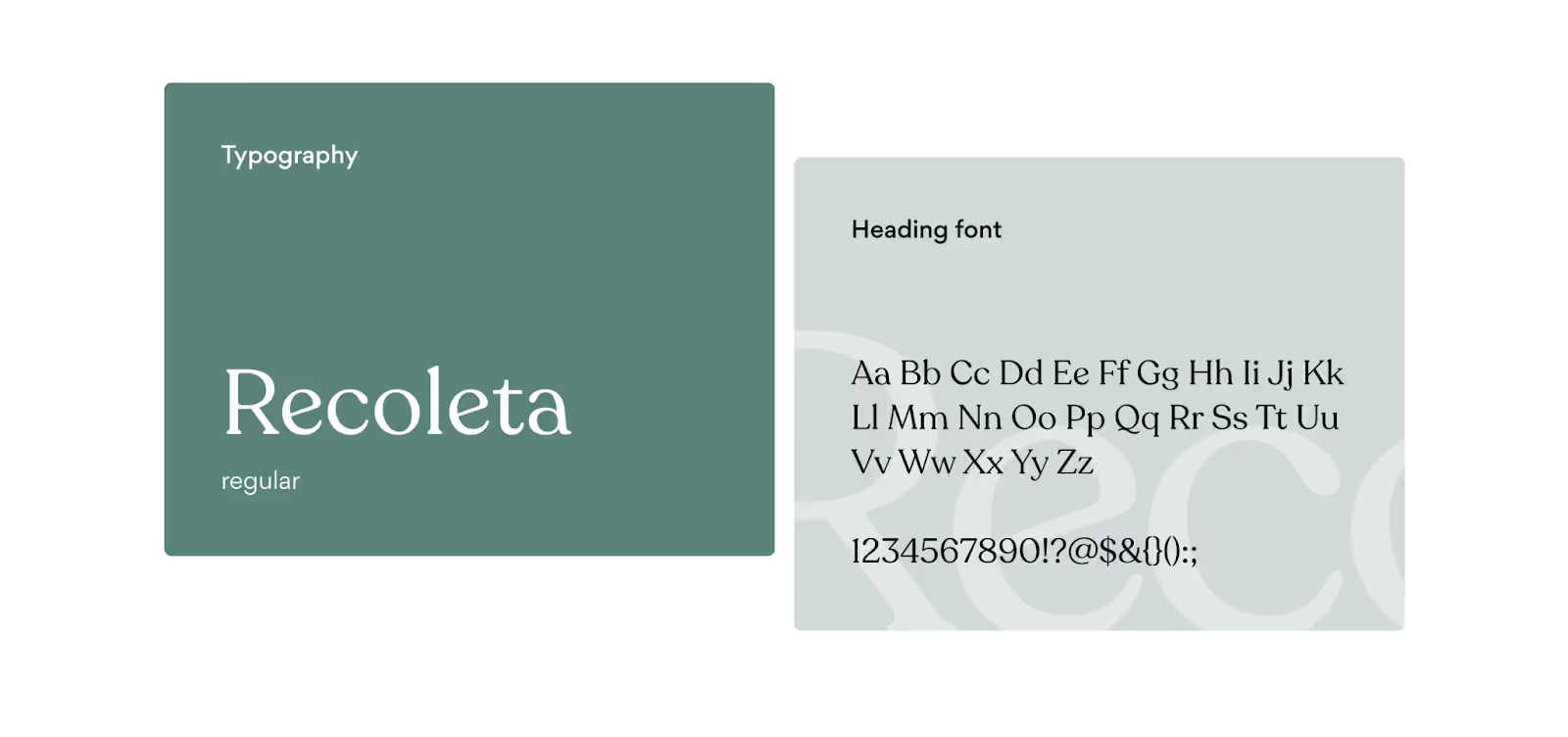
Our tip: Keep visuals consistent across all touchpoints, and use unique color schemes and artwork across all products, including all products, the website, app interface, marketing materials, and social media profiles. Create a detailed brand style guide that outlines your brand's appearance in various contexts, including logo usage, color codes, typography, and visual tone, to ensure that every aspect of your identity aligns with your brand's core values and goals.
Brand Messaging
Brand messaging is the language, tone, and key messages used to communicate with your SaaS brand. It defines your unique value proposition, distinguishes you from competitors, and directly addresses customer needs and pain points. It’s about effective communication with your audience.

Customer Experience
Customer experience (CX) involves every interaction a user has with the product (from the initial website visit to ongoing support and updates). What’s the most important at this stage? User onboarding! If users find your product clear and easy, they will continue using it. Make onboarding smooth and delightful, simplify steps, and use personalized messages to make users feel valued. Don’t forget to gather feedback (NPS surveys, user reviews, and customer support interactions) to improve the CX.
When you define all of these pillars, it’s time to take action and start the branding process.
Building Your Brand for a SaaS Business
What does a successful B2B SaaS branding require? Well, first of all, precision, strategy, and execution. You should craft an identity that resonates with your target audience, communicates value, and fosters trust over time. Our expert team helps you with actionable steps to build your SaaS brand. Let’s go!
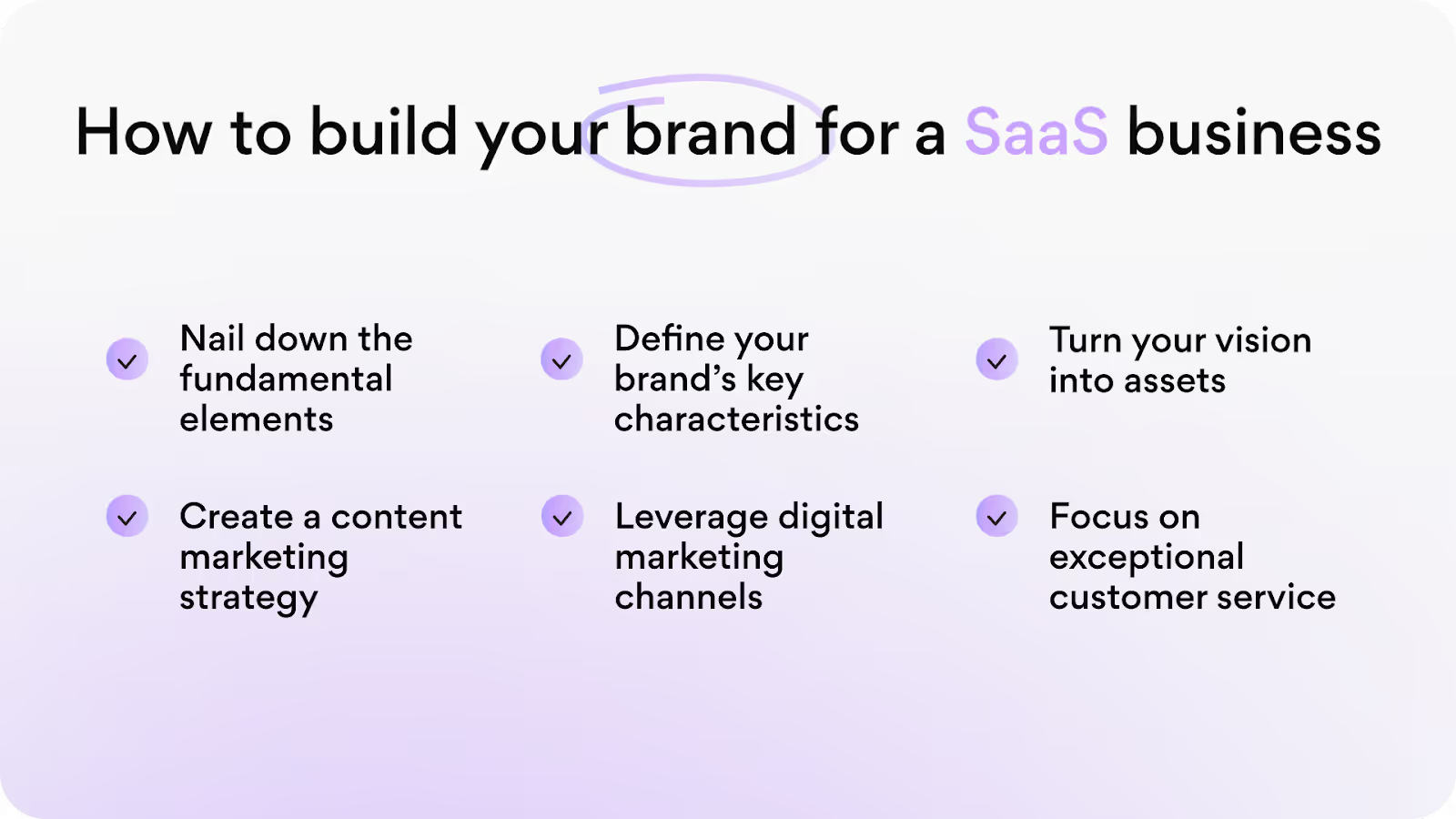
Nail Down the Fundamental Elements
The core elements of a brand are its mission, vision, and values! It's crucial to focus on relevance and clarity when crafting these elements. The mission should address the problem your software solves, the vision should articulate the impact you aim to make, and the values should reflect the principles guiding your operations.
Define Your Brand’s Key Characteristics
At this stage, you have to define key characteristics of your product or service to build an emotional connection with the audience. What to do? Develop a tone of voice, design style, and communication approach. Also, creating brand personas that reflect the target market is very helpful. We recommend researching the market and interviewing existing customers to find out their most valuable characteristics.
Turn Your Vision Into Assets
Identify your key elements and turn them into tangible brand assets:
- Logo
- Typography
- Color palette
- Product design
- Marketing materials
Each asset should represent the personality of your brand. For example, a minimalist design shows professionalism and dedication, while a colorful palette shows creativity and innovation. Think about your business: What would you like to indicate? The best solution here is to collaborate with designers to create a brand style guide, ensuring consistency across all platforms like the website, product interface, social media, and email campaigns.
Do you need a dose of inspiration? Take a look at one of our branding work for SaaS.

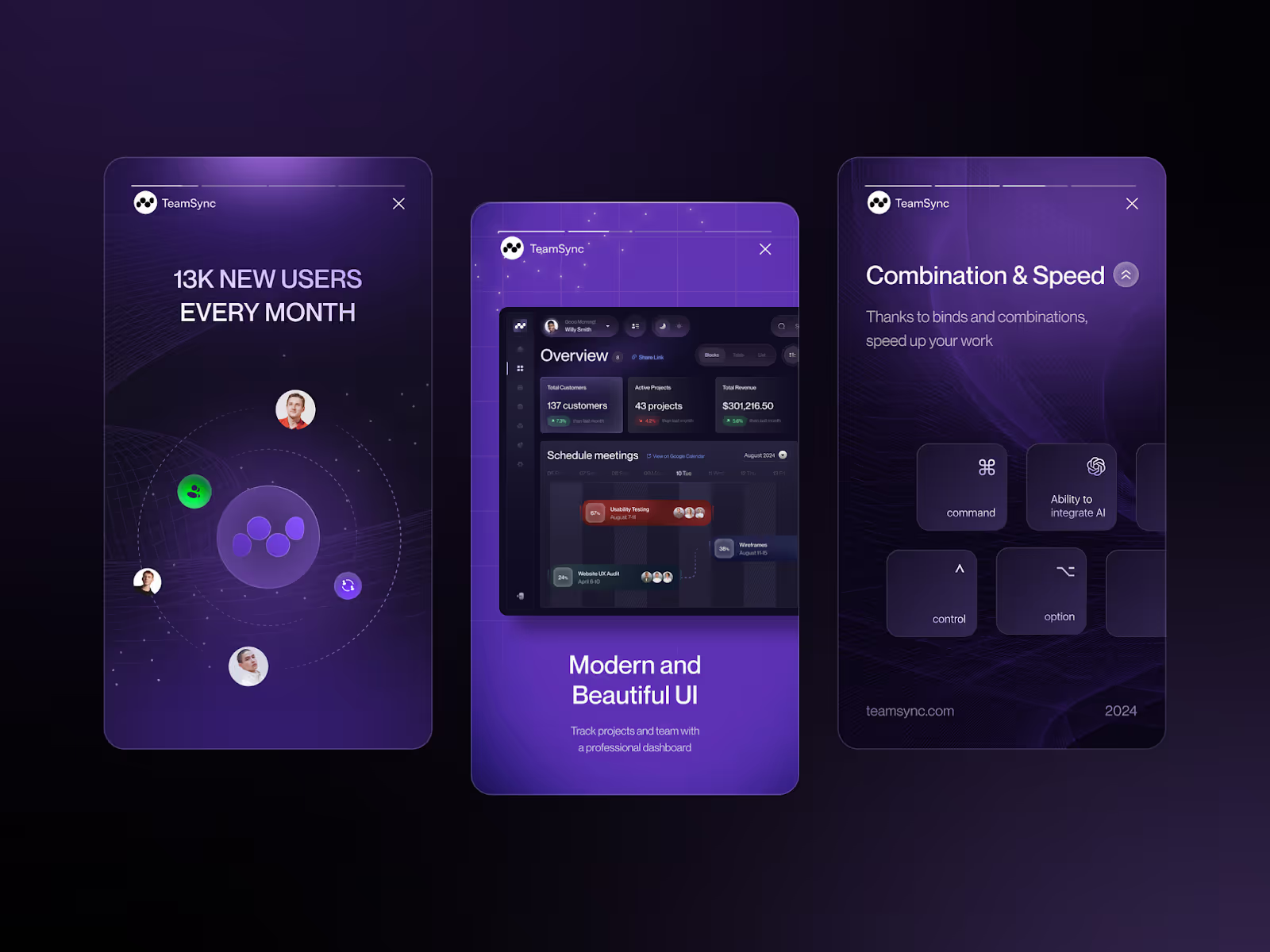
Find more amazing branding works here.
Create a Content Marketing Strategy
A strong content marketing strategy showcases expertise and builds trust with customers. Tailor content to each customer journey (including whitepapers, blog posts, webinars, and case studies) to highlight product value at different touchpoints. Arounda team recommends creating a content calendar that aligns with product launch cycles and marketing initiatives.
Leverage Digital Marketing Channels
Tell people about your SaaS brand on various digital channels (search engines, social media, and targeted advertising). Invest in SEO and use paid ads on LinkedIn, Google, and industry-specific platforms to drive long-term traffic and capture leads.
Keep in mind: B2B SaaS brands often favor LinkedIn because of its professional audience, while B2C SaaS companies may find a greater response on Instagram or X.
Focus on Exceptional Customer Service
Customer service is one of the most important things in SaaS brands! Nowadays, businesses suffer from high churn rates and want to increase lifetime value. Our Arounda experts suggest adopting a proactive customer success strategy, anticipating issues, offering training resources, and providing personalized recommendations. AI can help SaaS brands offer personalized service to their niche customer base to enhance their overall customer experience.
Now, let’s go deeper and create a roadmap!
SaaS Branding Roadmap
Building a powerful SaaS brand is a strategic process! And this is not an easy task. That’s why Arounda developed and shared a roadmap to guide you step-by-step. We offer essential strategies, tools, and expert tips for creating a lasting brand presence. We hope you like it 😉
Develop a High-Quality Product
A strong brand starts with a great product, which must solve real problems, provide value, and offer an exceptional user experience.
What Arounda team recommends:
- Prioritize product-market fit by conducting user research and gathering feedback during early development stages.
- Regularly update the product with new features based on customer input.
- Invest in a robust Quality Assurance process to ensure a bug-free user experience.
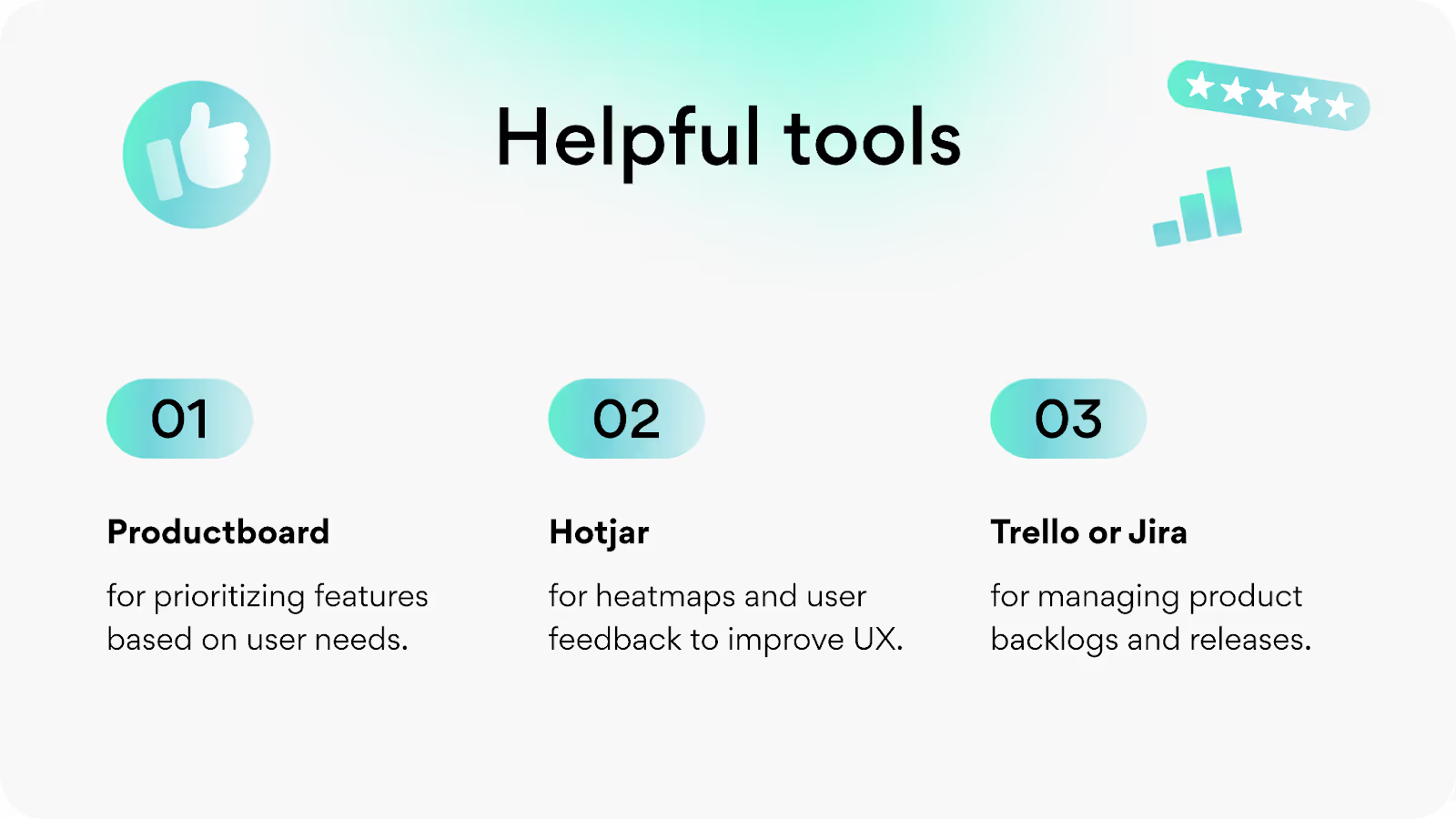
Build a Strong Brand Identity
Your brand identity sets your product apart in the SaaS market by reflecting your mission, values, and personality.
What Arounda team recommends:
- Use customer personas to understand how your ideal customers perceive and interact with brands (brand identity must meet their expectations).
If you need help building a strong brand identity, we will be happy to assist!
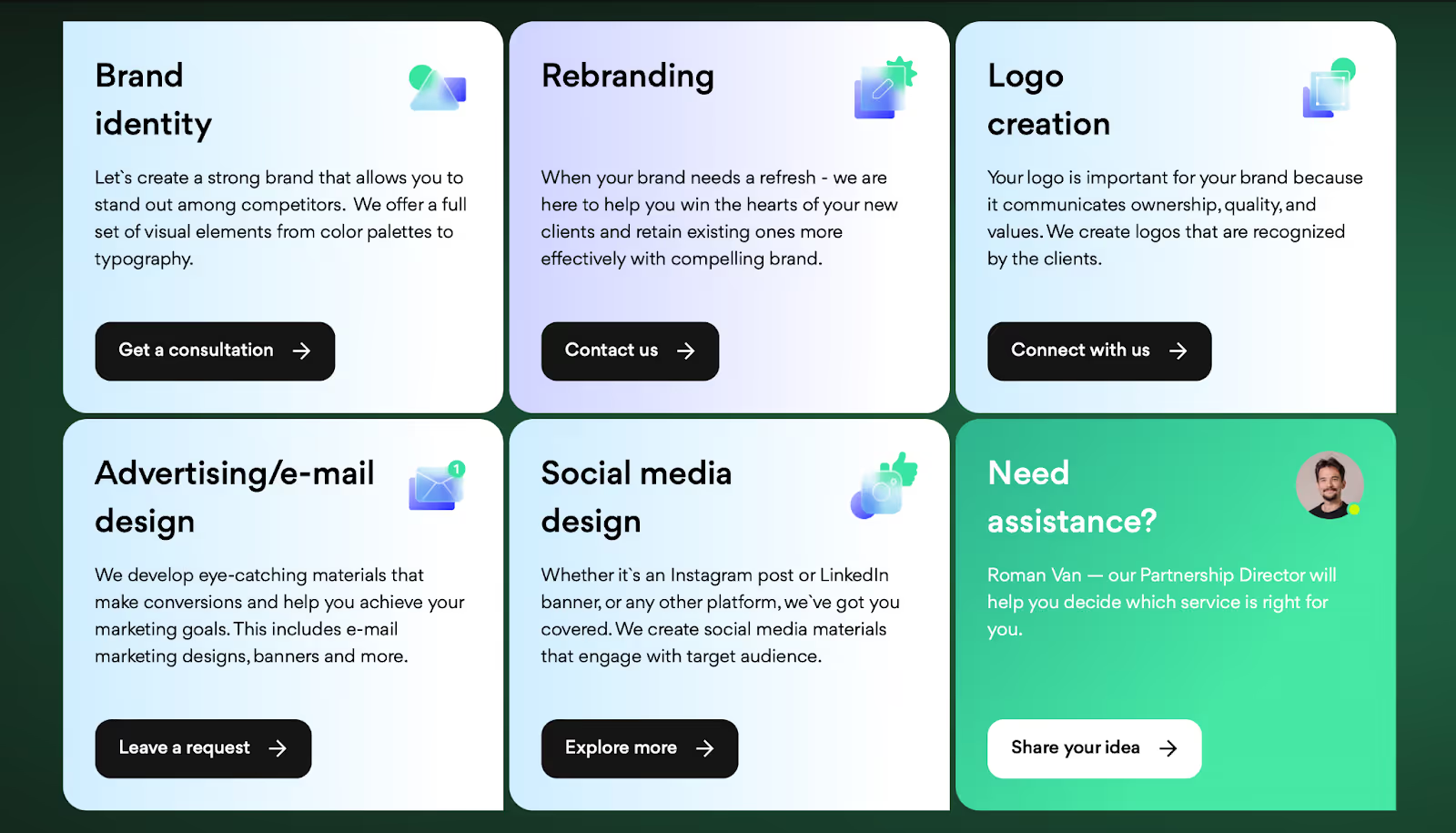
Design a Visual Identity Aligned with Your Brand
A visual identity comprises a logo, color palette, fonts, and imagery, creating a recognizable presence. It should reflect the product's value proposition.
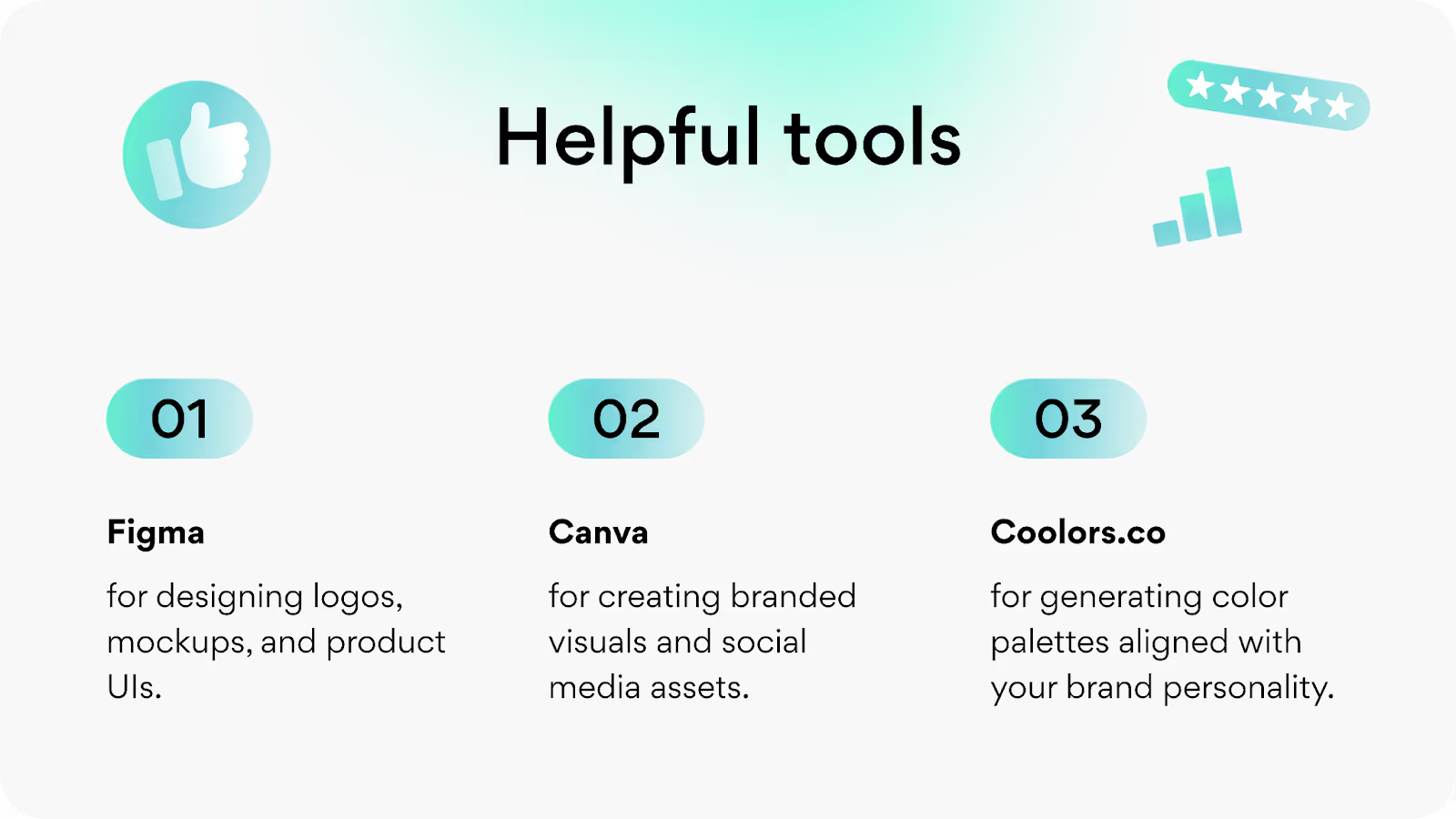
Create Marketing Materials
What can effectively communicate a brand's value? Marketing materials (pitch decks, case studies, whitepapers, email templates, and social media)!
What Arounda team recommends:
- Customize marketing materials for different buyer stages.
- Use educational content for lead generation and build trust with decision-makers.
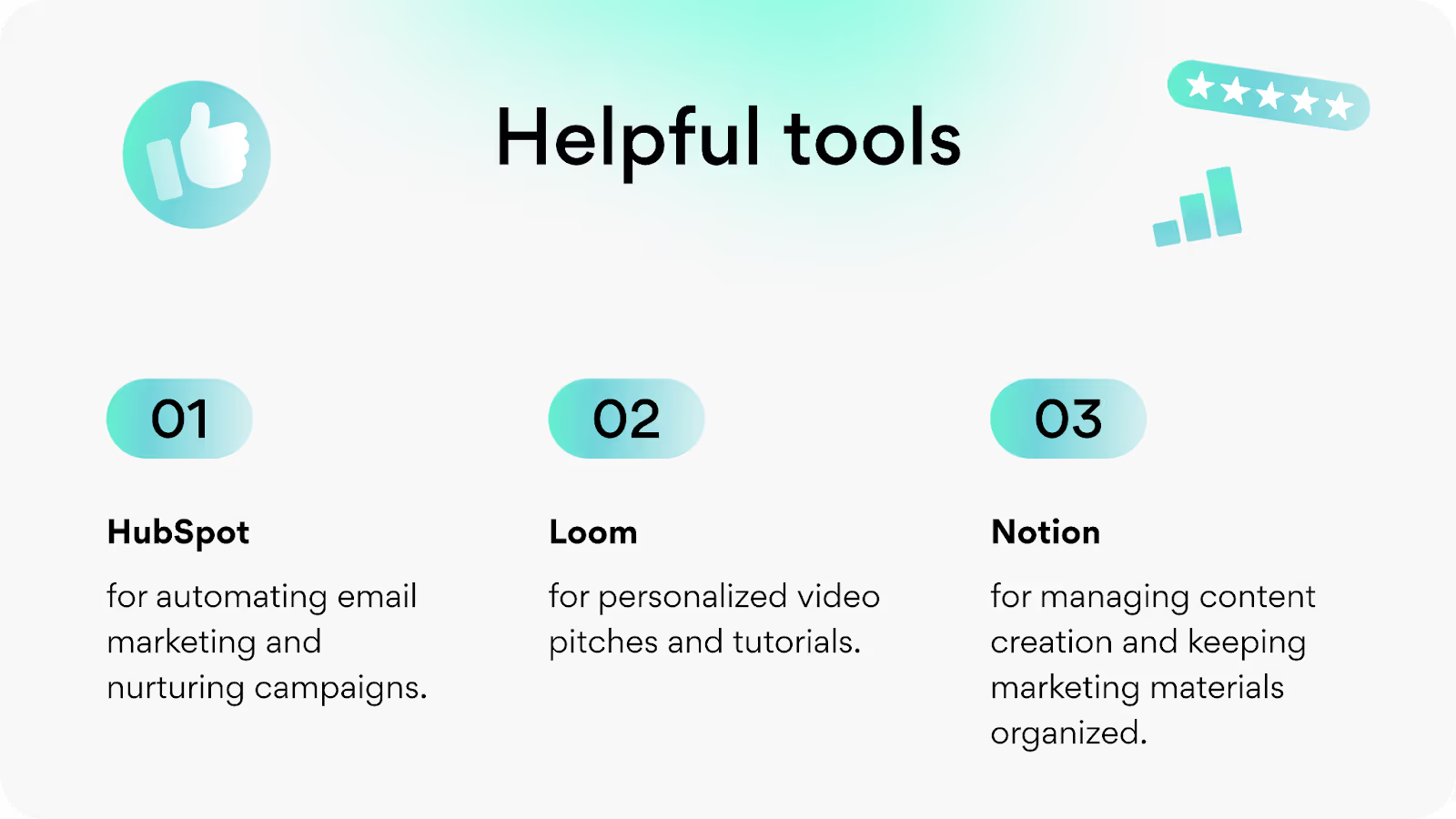
Train Your Team
Your staff is more than just people who do their job. Your team is the face of your brand across channels! Invest in brand training for employees to understand mission, tone, and visual identity.
What Arounda team recommends:
- Develop a brand playbook with guidelines for communication.
- Conduct regular workshops to keep team alignment.
Choose the Right Distribution Channels
To reach your target audience effectively, use the right distribution channels and apply a multi-channel strategy that mixes organic and paid efforts.
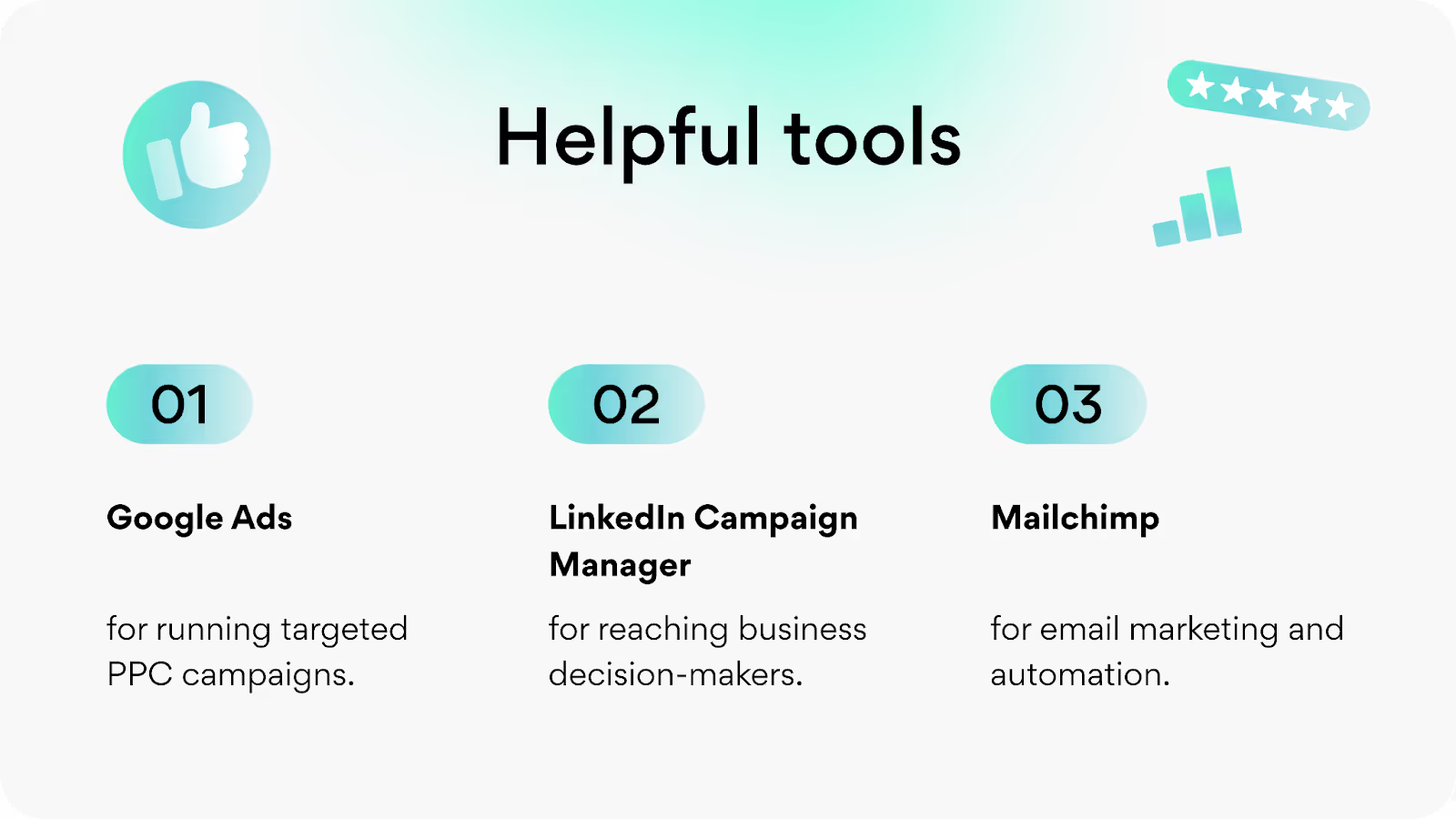
Ensure Brand Consistency
Inconsistent branding can weaken your credibility and confuse your audience. Every touchpoint (from your website to email newsletters) should reflect your brand identity! How do we keep consistency?
What Arounda team recommends:
- Use a brand style guide describing the visuals, tone of voice, and messaging across all platforms.
- Assign a brand manager or team members to oversee branding across different channels.
Stay Updated on Industry Trends
Staying updated is the most important thing in every digital business!
What Arounda team recommends:
- Regularly evaluate branding strategies to incorporate emerging trends like AI integration, sustainability messaging, and community-driven marketing.
- Monitor competitors and industry benchmarks to stay informed about customer preferences and technologies.
- Use Google Alerts, G2 or Capterra, and BuzzSumo to keep track of SaaS trends/news/customer sentiment.
If you're still not sure whether your SaaS needs really awesome branding, let's discover its benefits.
Key Advantages of Effective Branding
Investing in branding for SaaS offers long-term benefits by impacting customer acquisition, retention, and product positioning, driving sustainable growth, and improving business performance. Not too convincing? Okay, let's get into the details.
Builds Trust and Credibility
Trust is crucial in SaaS, where customers rely on software for critical business operations. Consistent communication of values, customer success stories, and transparency builds your brand credibility.
Strategies we recommend:
- Build credibility by sharing testimonials, success stories, and awards.
- Use third-party endorsements, certifications, and reviews on platforms like G2 or Capterra.
- Display security badges and certificates of compliance to reassure B2B buyers.
Boosts Brand Recognition and Recall
A memorable brand makes SaaS products the first choice for customers. A distinctive visual identity across all touchpoints, including website, emails, and product interface, with a strong logo, signature colors, and consistent tone of voice, reinforces recognition over time.
Think about your favorite brands and what makes them stand out. What can you learn from them?
Reduces Long-Term Marketing Costs
How can we reduce the need for ongoing advertising efforts? Invest in branding to build awareness and loyalty by generating inbound interest. SaaS companies with strong brands have a higher ROI on their marketing campaigns.

Strengthens Customer Advocacy
Who are brand advocates? Satisfied customers who promote your product, drive referrals and influence potential buyers. They also reduce churn and increase customer lifetime value. But users love reward systems! That’s why businesses create customer advocacy programs and showcase customer stories in marketing. Influitive and ReferralCandy tools can help manage customer advocacy programs and automate referral campaigns to incentivize word-of-mouth growth.
Example! Dropbox’s referral program encouraged users to invite friends and offered additional storage space. This advocacy-driven strategy was instrumental in its viral growth during the early stages.
Provides a Competitive Edge
Branding sets a product apart from competitors in a saturated SaaS market. When users are choosing between two similar products, they will pick the one with strong branding (something they know and trust), right?
It must reflect the product's capabilities and communicate the company's mission and unique value.
You might say, "The benefits are great, but what about the challenges? It can't be that easy!". Okay, now full disclosure.
Challenges in SaaS Branding
A strong SaaS brand requires continuous customer engagement and adaptability to market needs, unlike traditional products. We’ve gathered challenges in branding for SaaS products and offered expert tips to overcome them.
#1. Highly competitive market
How to deal with this challenge?
- Focus on your unique value proposition (UVP) in your SaaS product, using storytelling to highlight its impact.
- Invest in competitor research to identify gaps and opportunities, and align your branding strategy to highlight these differentiators.
#2. Evolving customer expectations
How to deal with this challenge?
- Regularly gather feedback to stay in tune with your audience's needs.
- Use the Survey tool to collect user feedback through in-app surveys and Typeform to track customer changing preferences.
#3. Aligning product experience with brand promise
How to deal with this challenge?
- Make sure product design and user experience (UX) match your brand messaging.
- Conduct UX audits regularly to identify and resolve pain points that could negatively impact customer perception.
- Use a brand-UX alignment framework that connects branding goals with UX priorities.
#4. Maintaining brand consistency across channels
How to deal with this challenge?
- Create a detailed brand style guide that outlines your brand’s tone of voice, visual elements, and messaging guidelines.
- Make sure every team member follows these guidelines to stay on track.
#5. Adapting to rapid industry changes
How to deal with this challenge?
- Follow industry leaders, attend SaaS conferences, and read thought leadership content to stay updated on industry trends.
- Use Google Trends to monitor trending topics in your industry and BuzzSumo to identify popular content to guide your thought leadership strategy.
#6. Building long-term customer relationships
How to deal with this challenge?
- Provide proactive support, personalized content, and regular updates.
- Use Intercom to manage internal messaging and customer engagement and ChurnZero to monitor churn risk and improve customer retention strategies.
When you overcome challenges and create your best SaaS branding, it’s important to measure success. How can you do this? Know key metrics, have a passion for improvements, and take action!
Key Metrics and KPIs to Measure Branding Success
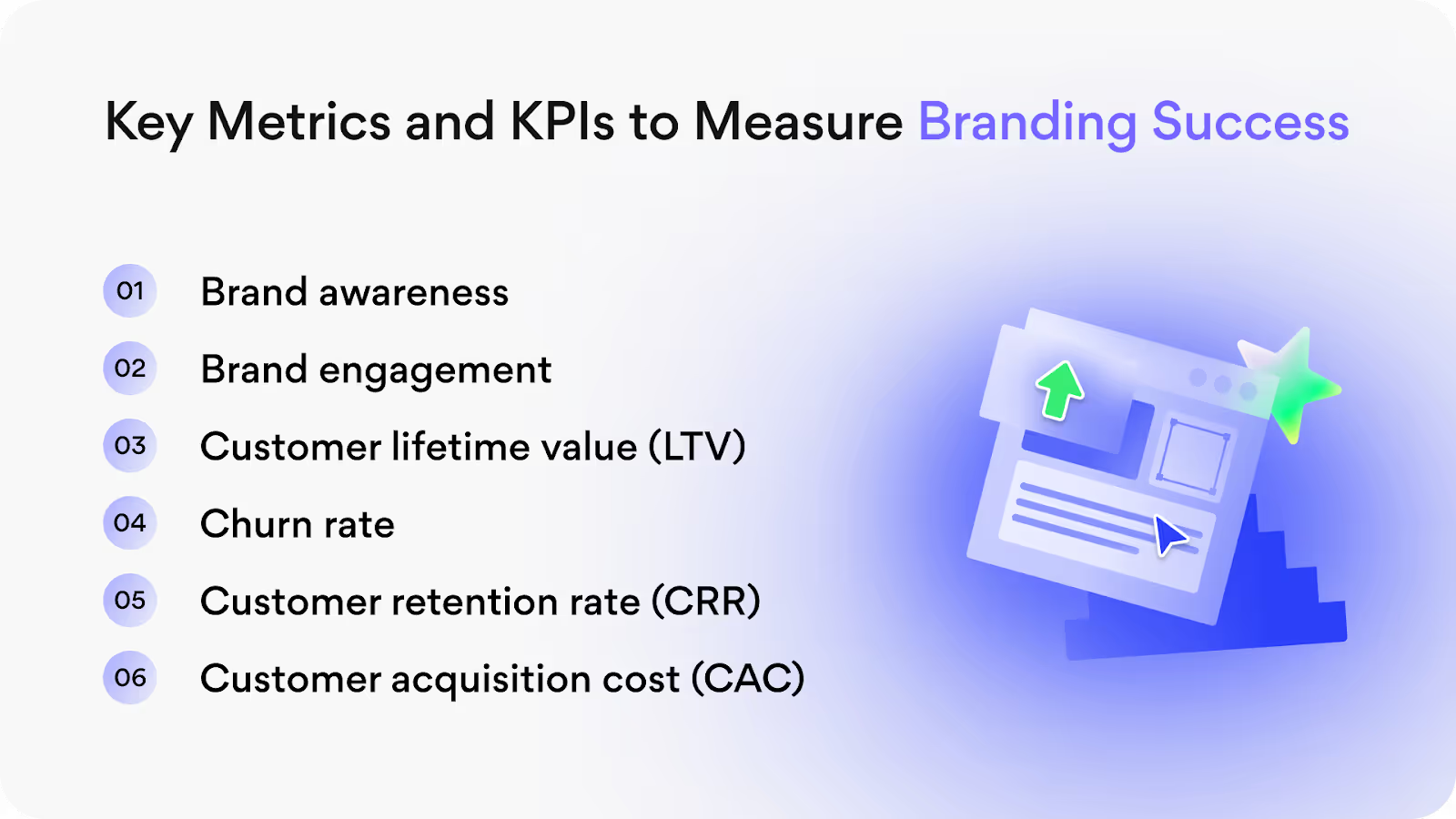
- Brand awareness
It means how well your target audience recognizes and remembers your SaaS brand. You should monitor direct traffic, search volume, and social media mentions. Google Analytics, Ahrefs/SEMrush, and Brand 24 can help you with this task.
- Brand engagement
It measures the level of interaction your audience has with your brand across various platforms, indicating their active participation and investment in the brand, which can lead to increased brand loyalty. Google Analytics, Hootsuite, and Mailchimp will help you with this task.
- Customer lifetime value (LTV)
It calculates the total revenue a customer generates during their interaction with your brand. Calculate LTV by multiplying the average customer value (revenue per customer) by the average customer lifetime. You can use Barametrics or Stripe to monitor LTV.
- Churn rate
It shows the percentage of customers who cancel their subscriptions within a given period. High churn rates mean customers are unsatisfied with your product or brand. What tools you can use to monitor and analyze this metric - ChurnZero, HubSpot, ProfitWell.
Churn rate = number of customers lost during a period / total number of customers at the beginning of that period.
- Customer retention rate (CRR)
It measures the percentage of customers you retain over a specific period. Baremetrics can help you track retention.
CRR = ((customers at the end of the period - new customers acquired during the period) / customers at the start of the period) x 100
Learn how to increase customer retention and get more profit from your SaaS in our article.
- Customer acquisition cost (CAC)
It shows the total cost of acquiring a new customer with marketing, sales, and branding efforts. Google Analytics, Salesforce, and HubSpot will help you track CAC.
CAC = total acquisition costs / number of new customers acquired during a specific period.
When you count your SaaS success, it’s time to share best practices and common pitfalls. Ready?
SaaS Branding Best Practices and Common Pitfalls
As in B2C and B2B SaaS branding, you need to focus not only on aesthetics but also on long-term relationships. Your main tasks are messaging consistency and value delivery. We know how complicated it is to create something extraordinary, so we share best practices to inspire you and pitfalls not to make mistakes!
Best Practices
- Align branding with customer expectations and business goals. Customer persona research helps tailor branding to target audiences, creating emotional connections.
- Focus on a user-centric experience. User onboarding programs and in-app messaging will help you guide new users toward quick wins.
- Provide consistent brand messaging across all channels with communication standards, visual elements, and tone of voice. Share this info with all team members.
- Use social proof and customer advocacy. Highlight customer success stories and testimonials in your branding campaigns.
- Invest in content marketing and thought leadership. Developing content that addresses industry challenges and solutions is very important to position your brand as a thought leader. Provide value through blogs, whitepapers, courses, eBooks, webinars, etc.
Pitfalls to Avoid
- Ignoring competitor analysis.
- Overpromising features or benefits and underdelivering them.
- Inconsistent branding across teams and channels.
- Neglecting UX audit, trends, and new customer needs.
- Focusing only on acquisition, not retention.
Need more inspiration (especially visual)? We have something for you! Our Arounda branding team is delighted to show you the projects we created. Take a look.
Final Thoughts
SaaS branding is:
- The secret tool differentiates you from the rest, builds trust, and drives long-term success.
- The promise you make to your customers, the story that inspires them, and the experience that keeps them coming back.
- The foundation for everything your business is founded on.
- The thing that creates impact, forms loyalty, and fuels growth.
This is your chance to create something unforgettable! Don't worry—the Arounda team is here to help. With our Brand Identity services and expertise in SaaS-oriented design, we'll take your brand from ordinary to extraordinary. It will reflect your vision and connect with your customers to build long-lasting relationships.















